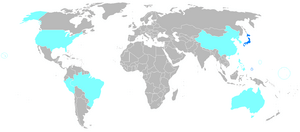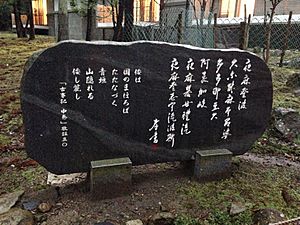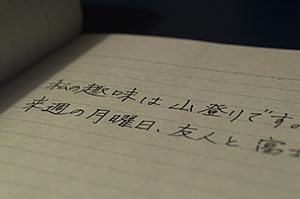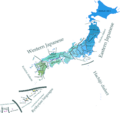Japanese language facts for kids
Quick facts for kids Japanese |
|
|---|---|
| 日本語 Nihongo | |

日本語 (Japanese language)
|
|
| Pronunciation | nihoŋɡo |
| Native to | Majority: Japan |
| Native speakers | 130 million/ (date missing) |
| Language family | |
| Writing system | Hiragana, Katakana, Chinese characters, romaji, Siddham script (occasionally in Buddhist temples.) |
| Official status | |
| Official language in | |
| Regulated by | None Japanese government plays major role |

The primary official language is Japanese. Japanese is a minority language.
|
|
The Japanese language is very different from English and most other European languages. Like Finnish, Turkish, and Korean, Japanese is an agglutinating language, with two (phonologically distinctive) tones like Serbian/Croatian and Swedish. It is a language where sentences need no subject and adjectives can have past tenses.
Contents
History
Little is known of the language's prehistory, or when it first appeared in Japan. Chinese documents from the 3rd century recorded a few Japanese words, but substantial texts did not appear until the 8th century. During the Heian period (794–1185), Chinese had considerable influence on the vocabulary and phonology of Old Japanese.
Sentence structure
Japanese uses three separate writing systems: hiragana, katakana, and kanji. The first two are phonetic systems (writing that shows the pronunciation of Japanese words), and kanji is the Japanese variation of Chinese characters (which show the meaning of Japanese words). The three systems are used interchangeably, and all three systems can often be found in the same sentence. The three systems are each reserved for different purposes.
In English, the order of the words is very important. For example, the sentences "Is it?" and "It is." mean different things. In Japanese a lot of these differences are made by adding or changing the endings of words.
Japanese often use titles of the person referred to where pronouns would be used in English. For example, when speaking to one's teacher, it is appropriate to use sensei (先生, teacher), but inappropriate to use anata. This is because anata is used to refer to people of equal or lower status, and one's teacher has higher status.
Politeness
The Japanese language can express differing levels in social status. The differences in social position are determined by a variety of factors including job, age, experience, or even psychological state (e.g., a person asking a favour tends to do so politely). The person in the lower position is expected to use a polite form of speech, whereas the other person might use a plainer form. Strangers will also speak to each other politely. Japanese children rarely use polite speech until they are teens, at which point they are expected to begin speaking in a more adult manner.
Study by non-native speakers
Many major universities throughout the world provide Japanese language courses, and a number of secondary and even primary schools worldwide offer courses in the language. This is much changed from before World War II; in 1940, only 65 Americans not of Japanese descent were able to read, write and understand the language.
International interest in the Japanese language dates from the 19th century but has become more prevalent following Japan's economic bubble of the 1980s and the global popularity of Japanese popular culture (such as anime and video games) since the 1990s. Close to 4 million people studied the language worldwide in 2012.
In Japan, more than 90,000 foreign students studied at Japanese universities and Japanese language schools, including 77,000 Chinese and 15,000 South Koreans in 2003. In addition, local governments and some NPO groups provide free Japanese language classes for foreign residents. In the United Kingdom, study of the Japanese language is supported by the British Association for Japanese Studies. In Ireland, Japanese is offered as a language in the Leaving Certificate in some schools.
Images for kids
-
A 12th-century emaki scroll of The Tale of Genji from the 11th century
See also
 In Spanish: Idioma japonés para niños
In Spanish: Idioma japonés para niños






